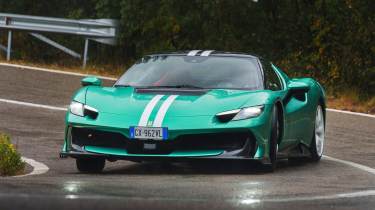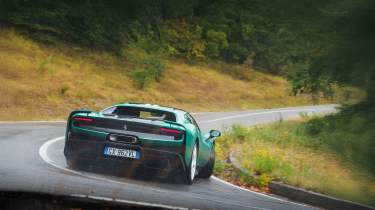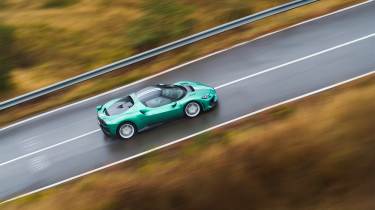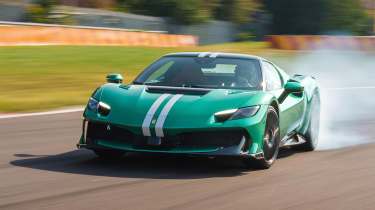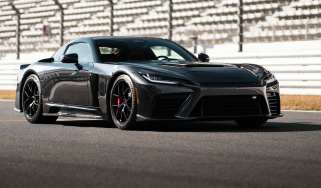Ferrari 296 Speciale review – does it live up to its legendary name?
Lighter, more powerful and with serious downforce the new Speciale is the most hardcore 296 yet
There can be few tougher acts to follow than the 458 Speciale. Pure, light and beautiful with a spine-tingling naturally-aspirated V8, it is one of the finest road cars Ferrari has ever built. And now it has a successor; the £359,779 296 Speciale.
The choice of name is telling. For where the other names associated with Ferrari’s sharpest mid-engined models - Challenge Stradale, Scuderia and Pista - speak of street cars with an overt track vibe, Speciale suggests an expanded skillset giving equal weighting to enhanced enjoyment on the road and maximum attack on track.
Visually the Speciale gives mixed messages. It boasts plenty of authentic race-bred details but stops short of being Ferrari’s answer to the 992 RS. At the front you’ll spot a larger front splitter combined with a large central duct which channels air into the nose and vents it through the frunk lid and up and over the windscreen and roof, just as in the 296 GT3 race car.
There are wider sills with a big intake in the trailing edge, a more pronounced diffuser and an active rear Gurney-style flap which rises into the airstream on demand (50% faster than the GTB) and now features a middle setting in addition to full deployment or retraction. Boomerang-shaped rear fins are mash-up of the vertical elements found on the 296 Challenge car and horizontal winglets from the FXX K.
More reviews
Combined the aero package develops 435kg of downforce at 155mph. Weight savings amount to some 60kg, with a claimed dry weight of 1410kg with lightest options fitted. Impressively, 15 per cent of that total saving comes from the engine, with new and extensively machined crankcase castings, titanium fixings, a nitrided steel crankshaft and new pistons and conrods taken from the F80 shedding some 9kg.
Powertrain-wise the gains in output are meaningful, with increased combustion chamber pressures and more precise control of the air-fuel mixture and engine maps influenced by the 296 Challenge car contributing to a 36bhp increase from the ICE. Improved cooling of the hybrid system yields a further 13bhp, lifting the combined power output to 868bhp, 49bhp more than the GTB and a new record for a series-production rear-drive Ferrari.
A new Qualifying mode has been added to the hybrid system, which works like the battery equivalent of turbo overboost to give an extra punch of up to 177bhp and 229lb ft when the V6 engine is running between 6000 and 8500rpm.
Like its exterior the Speciale’s interior continues the more sporting theme. Especially when fitted with lightweight seats, which look fabulous in red cloth and provide exceptional support without going to extremes. One-piece carbon fibre door cards and a full harness add to the competition car vibe, but there’s enough style and attention to finish and detail to ensure it doesn’t feel raw or stripped of luxuries.
The international media launch includes street and circuit driving elements. Our intention was to start at Fiorano, but Mother Nature doesn’t get the memo, so with the track drenched from an overnight downpour, we instead head out onto wet roads for our first taste of the new Speciale.
The sodden run from Maranello into the hills proves it is no skittish road racer. Yes, you immediately sense it has quicker wits and sharper claws, but such is the civility with which it conducts itself at low speeds you quickly relax. With the Manettino set to ‘Wet’ you can make progress with absolute confidence, electronics ensuring all that power and torque never get the better of the Cup 2s.
Once up in the hills switching to Sport releases more performance but retains a deeply impressive degree of digital control as the threshold of grip-slip-grip is raised. It’s amazing how clean and swift your progress can be in slick conditions in a car with such a surfeit of power.
The lower (by 5mm) and firmer Magneride adaptive suspension doesn’t fundamentally alter the Speciale’s character from that of the slightly softer GTB, but when you ask more of it you immediately sense its wits are quicker. Roll has been reduced by 13% and you feel that added cross-car support as soon as you make a steering input. Be it a minor adjustment of line or major change of tack, the Speciale is inspiringly energised and sweetly measured.
There’s plenty of feel, even as you make mid-corner transitions from wet to damp and dry sections. Switching to CT Off is not to be taken lightly, but so long as you’re progressive with your throttle inputs you can feel when the rising swell of torque starts to get the better of the rear tyres. What happens next is up to you.
It’s testament to the ICE and hybrid powertrain integration that you can play the throttle just at that point where the car is poised at the limit of traction, ebb and flow of fluctuating turbo boost pressure balanced against the immediate delivery of battery power.
Adding to the enjoyment is a faster and punchier gearshift that’s reminiscent of the F80, and a soundtrack which is louder, richer and more expressive than the regular GTB. The latter is thanks to a new system of acoustically tuned ducts, which draw sound from new positions around the 120-deg V6. It brings out more character from the V6 and - to my ears at least - sounds sweeter and more stimulating than the old twin-turbo V8.
Road driving done we arrive at Fiorano’s famous gates. The Speciale is a claimed 2sec quicker than the 296 GTB, lapping the 1.86-mile circuit in 1:19 dead. For context the outright record for a street-legal Ferrari is 1:15.3 set by the F80. Prior to that it was 1:17.3, set last year by the SF90 XX. And the old 458 Speciale? 1:23.5.
The car we’re driving on track differs from the one we drove on the road in so much as it is fitted with a passive damper set-up. At the time of writing this is the standard set-up for the Speciale, with the adaptive Magneride suspension listed as an option. However, Ferrari UK is currently in discussion with the factory to make Magneride (complete with nose lift) standard for the UK market, as it is far better suited to our rotten roads.
The Multimatic hardware is lighter than the semi-active system and the set-up is firmer (towards the upper end of the adaptive suspension in its stiffest mode) but there’s no claimed difference in terms of lap time. This said it’s worth noting that when test driver Raffaele di Simone set that new Fiorano record in the SF90 XX last year he elected to run on the optional passive set-up because he preferred the feel and it made sense to run the car in its lightest configuration.
First impressions driving the Speciale on the road were of greater steering connection, but on track it’s the flatness of the cornering that impresses. There’s still some lateral ‘give’, but it’s just enough to give you a read on how hard you’re working the front-end. It’s magic through the tricky medium speed direction changes. Where you imagine you’ll need to give the car a moment to settle between steering inputs, the Speciale cuts from right-to-left and left-to-right with the briefest of micro-pauses.
Ferrari’s ABS Evo system really is redefining on-limit braking in street cars. You can’t work the Speciale quite as hard as an F80, but it’s remarkable how you can have it stood on its nose and still put significant lateral load into it as you extend the braking zone into the heart of the corner. There’s fabulous feel to go with the power. You can make delicate changes to brake pressure, blending out of the pedal j-u-s-t enough to keep the weight on the nose but still allow the car to carry more speed into the apex.
With the best part of 870bhp sent exclusively to the rear axle, the Speciale demands respect in CT Off or ESC Off modes. It's playful exiting the low-speed corners and manageable through the medium-speed stuff, but there’s so much power and torque on-tap that it’s possible to get it out of shape on the exit of high-speed corners if you’re greedy. When you’re not pushing to the limit this means you can slide it around for fun; something it’s very good at.
Hammering around Fiorano reveals the Speciale is both seriously fast and fun, and confirms it makes the same significant strides over the 296 GTB on track as it does on the road. Pleasingly this is due to some meaningful trickle-down of technology from the F80, which has helped amplify the character and capability of the 296.
Comparisons to the 458 Speciale are inevitable, but such are the fundamental differences in powertrain character and technology it’s hard to draw useful parallels. Better to look back upon the 458 as the zenith of Ferrari’s naturally aspirated V8 era and see the 296 as a rising star.
Frustratingly, without dry running on a broader range of roads it’s not possible to give a definitive verdict on just how good this new Speciale is. What we can say is it’s meaningfully sharper, keener, grippier and more connected than the regular GTB, yet also more agile and expressive. It intensifies the 296’s already rabid performance and deepens the sense of excitement and occasion you get from driving it. Not just at the limit, but from the moment you fire it up. The 296 has come of age.
